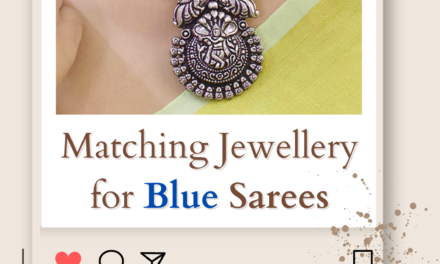How to Drape a Saree? The saree, a quintessential Indian garment, is not just clothing; it’s an art form, a cultural symbol, and a timeless fashion statement.
Draping a saree can be intimidating for beginners, but with a step-by-step guide, it becomes an enjoyable experience. Whether you’re preparing a saree for a special occasion or simply want to embrace this elegant attire, this comprehensive guide will teach you how to drape a saree with finesse.
Note: Know Your Saree Size. & choose the Branded blouse and Branded Saree option for the perfect Saree Outfit.
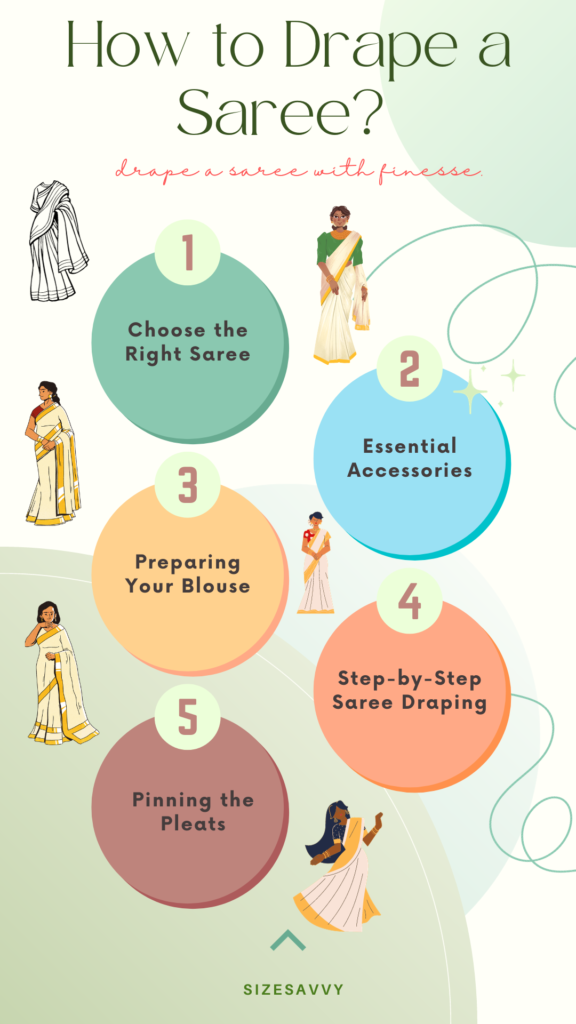
How to Drape a Saree?
| Saree Draping Steps | Saree Drape Instructions |
|---|---|
| 1 | Start: Begin by tucking the plain end of the saree into the petticoat (underskirt) at your navel. Make one complete turn, ensuring the lower end of the saree touches the floor. |
| 2 | Pleats: Make 5-7 pleats of about 5-7 inches each, and hold them together neatly. |
| 3 | Tuck Pleats: Tuck the pleats into the petticoat, slightly towards the left of the navel, ensuring they open to the left. |
| 4 | Pallu: Take the pallu (remaining length) and drape it over your left shoulder. Adjust the length according to your height. |
| 5 | Pinning: Secure the pallu with safety pins on your left shoulder to prevent slipping. |
| 6 | Final Adjustments: Adjust the pleats and the pallu to fall gracefully. Make sure the saree is comfortably draped and secure. |
| 7 | Accessorize: Complete your saree look with matching accessories, such as bangles, necklaces, and earrings. |
| 8 | Footwear: Wear high heels for the perfect fall of the saree. |
Remember, practice makes perfect. Don’t hesitate to experiment with the pleats and pallu.
1. Choose the Right Saree

Selecting the appropriate saree is crucial. Consider the occasion, Saree for your body type, and your style. Light fabrics like georgette and chiffon are ideal for casual wear, while silk sarees like Kanjeevaram or Banarasi are perfect for weddings and formal events.
2. Essential Saree Accessories

Before you start draping your saree, gather these accessories:
- Blouse: Ensure it fits well and complements your saree.
- Petticoat: Match its color to your saree.
- Saree Pins: To secure the pleats.
- Safety Pins: For securing the pallu.
- Bangles: To match your saree’s colors.
- Footwear: Heels or flats, depending on your comfort.
3. Preparing Your Saree Blouse
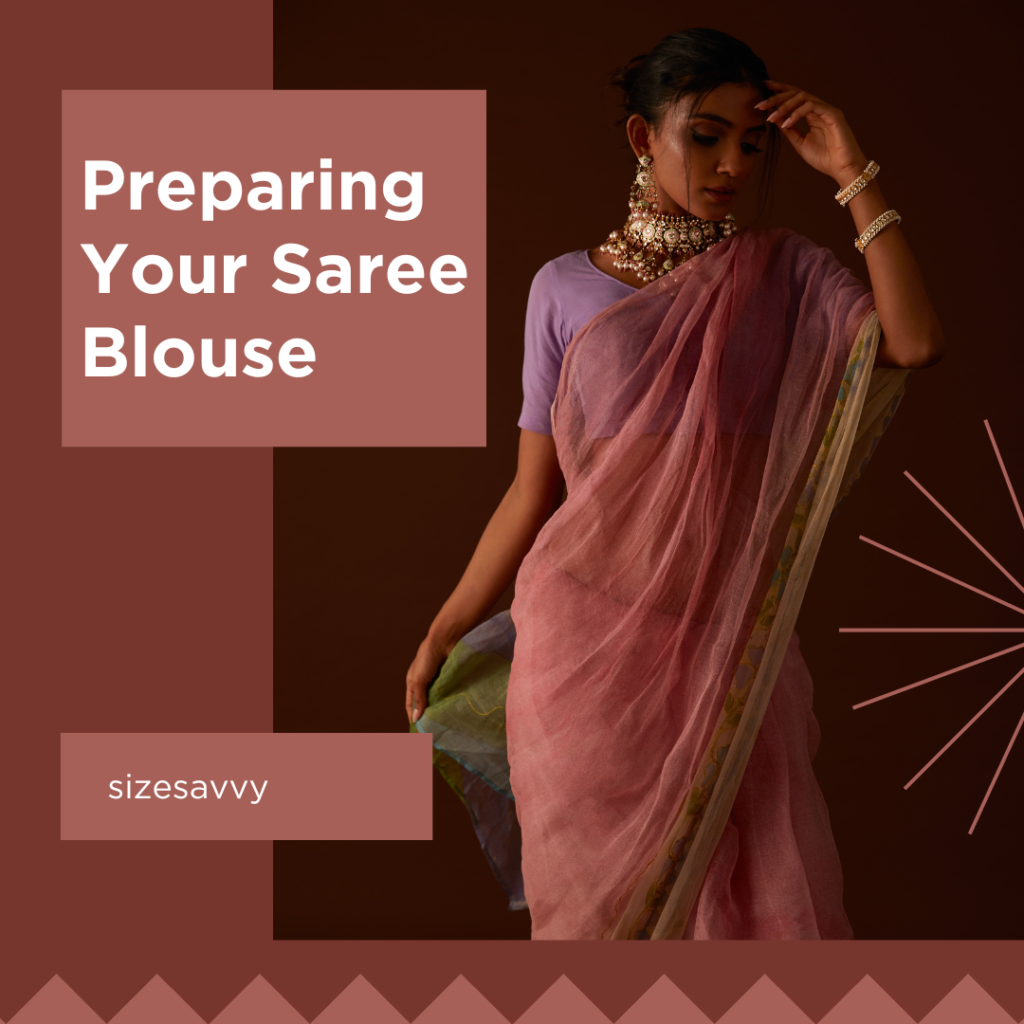
Ensure your blouse and petticoat are well-fitted. The blouse should have hooks or ties at the back. If it’s your first time, consider a readymade saree blouse for convenience.
4. Step-by-Step Saree Draping
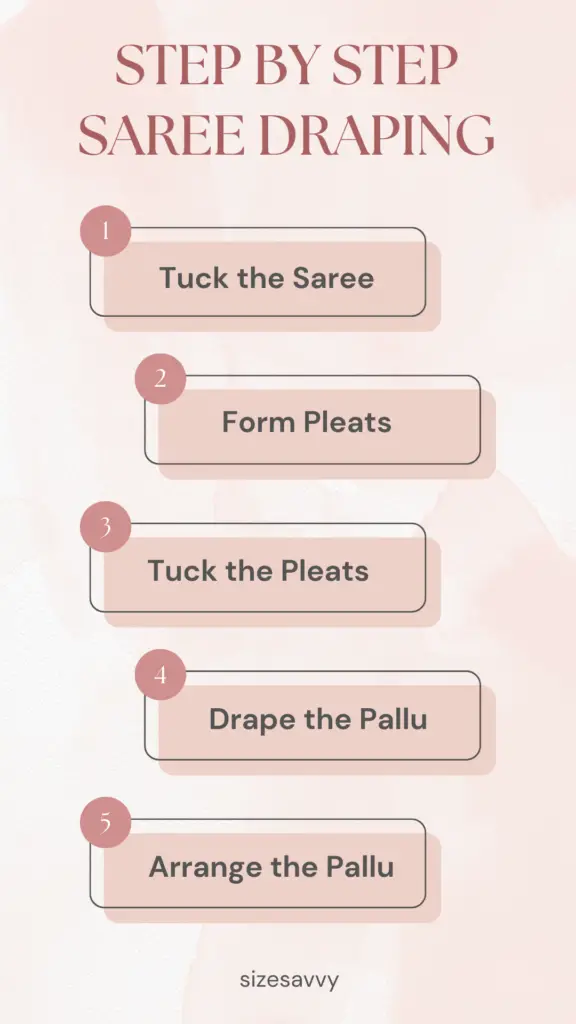
a. Tuck the Saree
- Start by tucking the plain end of the saree into the petticoat at your right hip. Make one complete turn and tuck it securely.
b. Form Pleats
- Gather the loose end of the saree and make pleats (5-7) neatly, ensuring they face left. Adjust the length as needed.
c. Tuck the Pleats
- Tuck the pleats into the petticoat, slightly to the left of your navel. This is the front of your saree.
d. Drape the Pallu
- Take the remaining fabric (the pallu) and bring it over your left shoulder from back to front, allowing it to fall gracefully.
e. Arrange the Pallu
- Adjust the length and arrange the pallu’s pleats to hang elegantly.
5. Pinning the Pleats
Use saree pins to secure the pleats and pallu in place. Make sure the pallu is pinned to your blouse to keep it in position.
6. Draping Styles
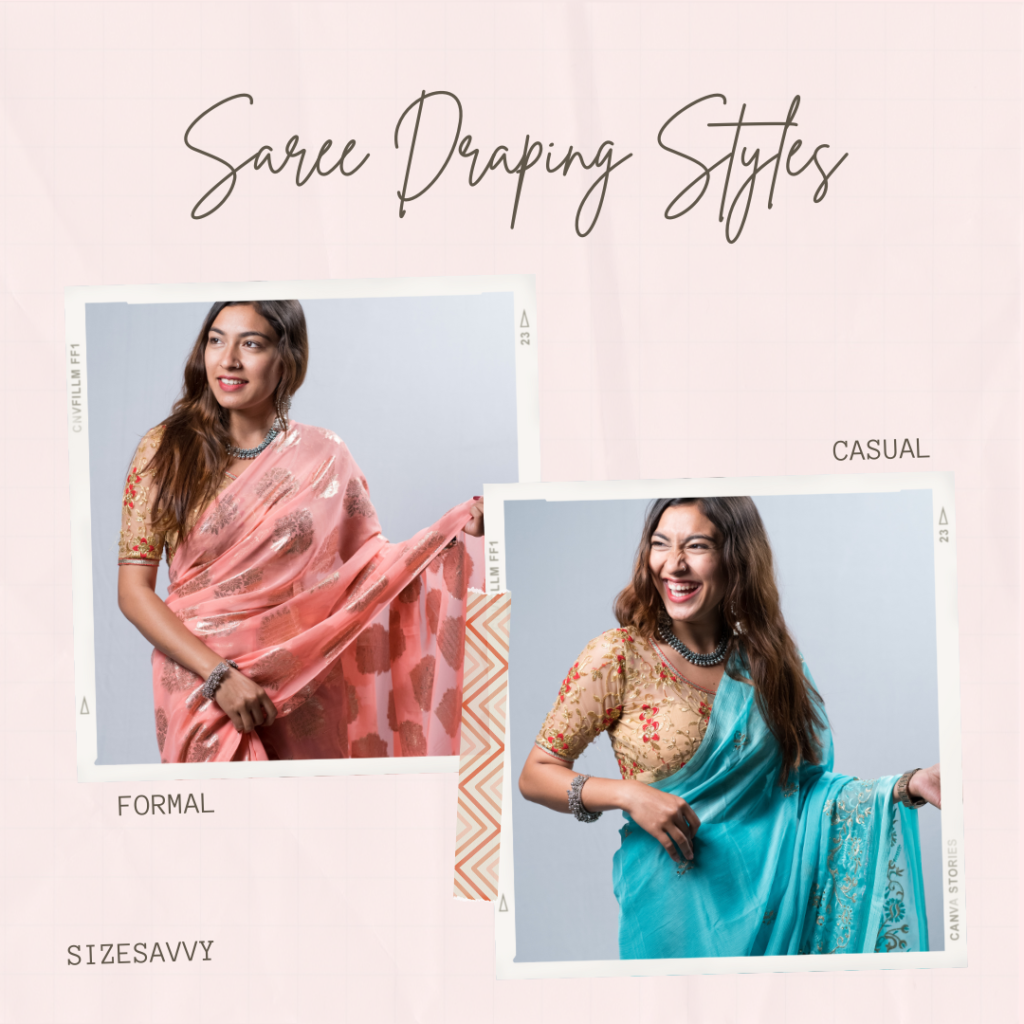
Experiment with various draping styles to find what suits you best. Popular styles include the Nivi drape, Bengali drape, and Gujarati drape.
7. Common Saree Draping Mistakes

Avoid these common mistakes:
- Uneven pleats.
- A sagging pallu.
- Ill-fitted blouse.
- Poorly secured pins.
Different Types of Saree Draping Styles
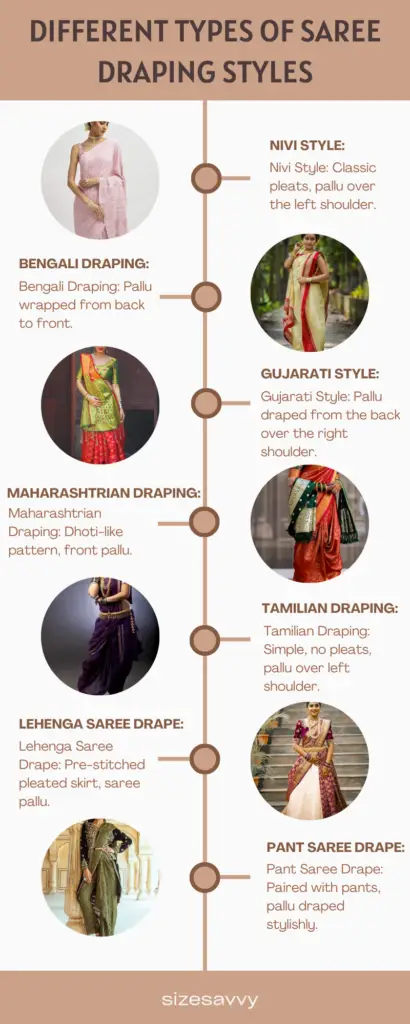
Sarees offer a canvas for creativity, with diverse draping styles:
- Nivi Style: Classic pleats, pallu over the left shoulder.
- Bengali Draping: Pallu wrapped from back to front.
- Gujarati Style: Pallu draped from the back over the right shoulder.
- Maharashtrian Draping: Dhoti-like pattern, front pallu.
- Tamilian Draping: Simple, no pleats, pallu over left shoulder.
- Lehenga Saree Drape: Pre-stitched pleated skirt, saree pallu.
- Pant Saree Drape: Paired with pants, pallu draped stylishly.
- Butterfly Style: Pleats resemble butterfly wings, an artistic look.
- Mermaid Style: Neatly tucked pleats, accentuating curves.
Each style echoes tradition and creativity,
Tips for Saree Draping
Here are some tips to drape your saree with style and grace:
- Choose the Right Saree Fabric: Different fabrics drape differently. Lighter fabrics like georgette and chiffon flow gracefully, while silk sarees have a more structured drape. Choose a fabric that suits the occasion and your comfort.
- Invest in Good Quality Petticoat: A well-fitted petticoat is the foundation of a well-draped saree. It should match the saree color and sit comfortably at your waist to ensure the saree falls elegantly.
- Perfect the Pleats: Neat pleats are the hallmark of a well-draped saree. Make sure the pleats are of equal width and neatly folded. Secure them tightly to maintain the saree’s structure.
- Pallu Draping Styles: The pallu (the loose end of the saree) can be draped in various styles. Experiment with styles like seedha pallu (front pallu) or ulta pallu (back pallu) to change the overall look.
- Adjust the Length: The length size of the saree should graze the floor, allowing you to walk comfortably. Too short or too long can hinder your movements.
- Pin Strategically: Use safety pins strategically to secure the pleats, pallu, and borders. Make sure the pins are not visible, especially if you’re wearing a sheer or transparent fabric.
- Practice Makes Perfect: If you’re new to draping sarees, practice different draping styles. Watch tutorials online, and practice with an old saree to gain confidence and finesse.
- Balance the Accessories: Choose the right accessories like bangles, earrings, and necklaces that complement the saree. Avoid heavy accessories if your saree is heavily embellished.
- Mind Your Blouse: The blouse’s design and fit can impact the overall saree look. Ensure your blouse complements the saree, both in design and color.
- Walk Confidently: Confidence is key. Walk with small, graceful steps, allowing the saree to sway naturally. Practice walking before the event to get used to the drape.
Remember, each saree style has its unique draping technique. Experiment, and enjoy the process.
Conclusion: Draping a saree is an art that enhances your grace and elegance. With practice and patience, you can master it. Remember, confidence is the key to carrying a saree effortlessly. Experiment, enjoy, and embrace this timeless piece of Indian fashion.
FAQs on Saree Draping
Can I drape a saree without help?
Yes, with practice, you can drape a saree independently.
How long should my saree be?
Standard saree lengths vary from 5.5 to 9 meters; choose based on your comfort and height.
What if my saree is too long?
Trim the extra length before draping, or tuck it into the petticoat more times.
Can I drape a saree in different styles?
Absolutely! Explore various draping styles to suit different occasions.
What is the easiest saree to drape?
The ease of draping a saree depends on personal experience and comfort. However, sarees made of lightweight and flowy materials like chiffon, georgette, and crepe are often considered relatively easier to drape due to their flexibility.
How to drape a saree hacks?
There are several hacks to make saree draping easier, such as using pre-stitched or pre-pleated sarees, using a saree belt or petticoat with drawstrings, and securing pleats with safety pins.
How to arrange saree pleats?
To arrange saree pleats, hold the saree firmly at the waist, make even folds to create pleats, and adjust them as needed. Ensure they are uniform and well-aligned before tucking them in.
Which saree drape makes you look slim?
The most commonly used drape to create a slimming effect is the “Bengali” or “Bengal-style” saree drape, where the pallu is draped from the back to the front. It creates a slender silhouette.
How many pleats are good for a saree?
The number of pleats in a saree can vary, but a common range is around 5 to 7 pleats. Adjust the number based on your comfort and the length of your pallu.
How to get perfect hip pleats in a saree?
To get perfect hip pleats in a saree, ensure that you have enough fabric to create pleats and tuck them securely at the waist. Smoothly arrange the pleats to sit flat on the hip.
Which saree is easy to pleat?
Lightweight and smooth fabrics like chiffon and georgette are relatively easy to pleat due to their pliable nature.
Can you wear a saree without pleats?
While pleats are a traditional part of saree draping, some modern draping styles or pre-stitched sarees eliminate the need for pleats, offering a unique look.
Is a fall necessary for a saree?
Adding a fall (lining) to the saree is not necessary, but it can help protect the saree’s lower edge from wear and tear. It’s commonly added to heavier or more expensive sarees.
What is the most common style of saree drape?
The most common style of saree drape is the “Nivi drape,” which involves pleating the saree and draping it over the left shoulder, with the pallu hanging down the front. This style is popular and versatile.
Is a tissue silk saree easy to drape?
Tissue silk sarees are generally easy to drape due to their lightweight and pliable nature. However, the ease of draping can also depend on the individual’s experience with saree draping.
Is a chiffon saree easy to drape?
Chiffon sarees are relatively easy to drape due to their lightweight and flowy texture. They are often favored for their comfort and simplicity in draping.
Is a cotton saree easy to drape?
Cotton sarees can be easy to drape, especially if they are lightweight and well-starched. However, some thicker or heavily embellished cotton sarees may require more effort in draping.





